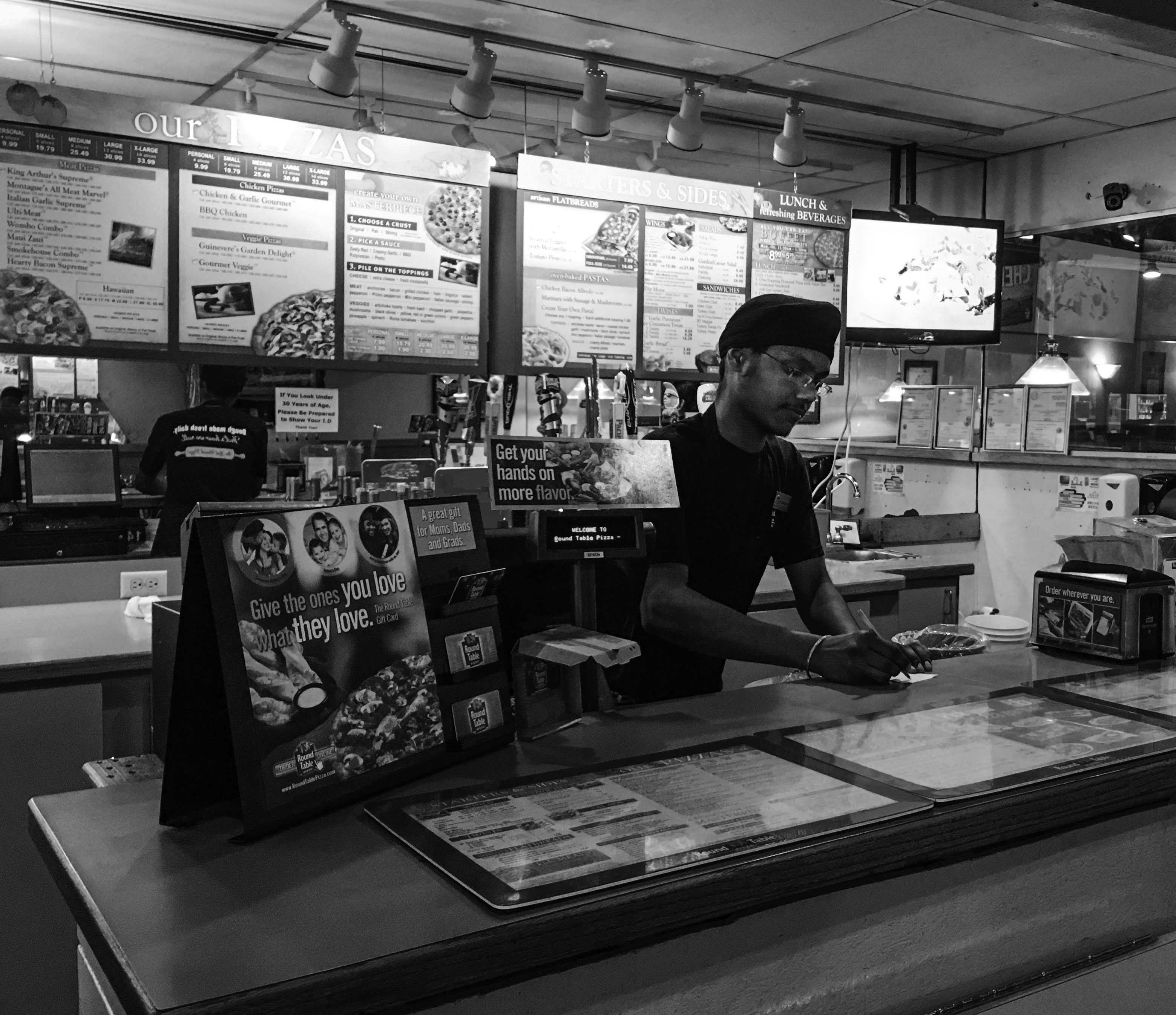Forty hours at Round Table Pizza off of University Avenue and 30 hours at 7-Eleven on Waverly Street — in total, these 70 hours constitute an average week’s work for minimum wage employee Joban Deep.
As one of many minimum wage employees working in Palo Alto to eke out an equally minimum livelihood, Deep works seven days a week to earn the $1,300 necessary for him to survive for a month in the Bay Area. Additionally, Deep says he sends $2,000 a month home to support his parents, who are rice and wheat farmers in Pilibhit, one of India’s poorest municipalities. He lives in a two-bedroom apartment in Santa Clara with his cousin and two friends. The four rely on each other to pay the $2,800 monthly rent.
“Employees [in Palo Alto working minimum wage] are coming from Mountain View, Sunnyvale, Santa Clara,” Deep says. “No one actually lives here.”
Deep says he and his friends are far from being able to afford living in Palo Alto, where rents are over 11 times higher than the national median, according to Zillow’s Home Value Index. While Palo Alto’s first ever local minimum wage was set $2 above the statewide minimum at $11 an hour on Jan. 1, 2016, it is only one and a half times the national minimum wage.
“We’re all in this together,” says James Keene, the City Manager of Palo Alto. “This town recognizes that fact, and the council is trying to invest in the programs that can make that better.”
Deep earns the $11 minimum wage at 7-Eleven and just above the local minimum wage at Round Table Pizza where he is paid roughly $14 an hour as a manager.
“Palo Alto is very expensive,” Deep says. “I think the minimum wage should be around $14 because it’s very expensive.”
A “Fight for 15” movement has been sweeping across the nation, calling to raise the minimum wage to a “liveable” $15 an hour. The State of California passed a law on April 4 providing for a statewide minimum wage increase to $15 an hour by 2020. However, unions that include employees who work in the Bay Area like Service Employees International Union have been leading a movement to raise the minimum wage by 2018.
“[Palo Alto] has a goal of reaching $15 by 2018,” says Marc Berman, a member of the Palo Alto City Council. “We still need to do some work on the council level to determine when those increases will happen, but we also have to be respectful of our business community.”
Service Employees International Union member Margaret Adkins continues to advocate for the implementation of a $15 minimum by 2018. Adkins, a program assistant for the City of Palo Alto, has participated in SEIU organized events to raise the minimum wage while working around minimum wage at three side-jobs in order to keep pace with the cost of living in the area.
“Housing is a right,” Adkins says. “Everybody should have housing, food and health care, which are basic needs. Raising the minimum wage is a way of getting closer to meeting those [needs].”
Cheesecake Factory employee and San Jose State University student Eddie Benito says he is only able to live in Mountain View because he shares subsidized housing with a friend and has scholarships that cover his tuition.
“I’ve been really lucky with housing,” Benito says.
Larry Moody, the vice mayor of East Palo Alto says businesses must remember that they cannot function without their minimum wage employees.
“It makes sense to make sure your workforce earns a reasonable wage so they can stay in the region,” Moody says. “The business community has to guard their assets, including good quality employees.”
Students Working at Minimum Wage
Alongside minimum wage workers such as Deep, according to a survey administered by Verde, 33 percent of Palo Alto High School students have worked or currently work minimum wage jobs, and with summer approaching, many more may take up minimum wage employment.
For students such as Palo Alto High School senior Sophie Swezey, who works at minimum wage to earn pocket money, rather than to support a family, the job can be liberating rather than restricting.
“I’m still living at home so I don’t have to pay rent, or for my utility bills, or that sort of thing,” Swezey says. “It’s a couple hundred dollars every few weeks. It’s just enough that I don’t have to ask my parents for money to buy lunch. It gives me independence, but it’s also made me a lot more cautious with my money.”
However, for students like Philz Coffee barista Molly Kraus, who are working to pay their college tuition, entry level wages feel constricting.
“I’m working between 20 to 25 hours a week,” Kraus says. “As much as I work, it doesn’t feel like much money.”
Kraus, who earns just above minimum wage, explains the degrading nature of low pay.
“It’s demeaning to be paid so little, especially in Palo Alto where a lot of kids don’t have to take on low paying jobs,” Kraus says.
Vice Mayor of East Palo Alto, Larry Moody points out how the phrase “minimum wage worker” is especially degrading to adults who spend their whole lives earning minimum wage.
“‘Minimum,’ in itself, is an adjective that can be demeaning,” Moody says. “I don’t know how much dignity is associated with that. When you’re looking at individuals who are the primary caregivers for their family, people need that term to be removed and for livable wages to emerge as the theme of the day.”
Achieving a Liveable Wage
Campaigns for minimum wage aim to achieve a liveable wage, however simply raising the minimum wage may not be the answer.
“It stinks because once the minimum wage gets raised, all the other prices get raised,” Benito says. “It’s give and take.”
According to the American Legislative Exchange Council, a 10 percent increase in minimum wage would result in a four percent increase in food prices.
Moody notes that while a raise to $15 will help to an extent, minimum wage workers’ quality of life will remain at minimum.
“$15 an hour allows families to take care of their basic needs,” Moody says. “It doesn’t allow them access to the quality of life that people who have college degrees have access to.”
To Moody, finding a way to keep the minimum wage at a sustainable level for the economy while allowing workers earning minimum wage to sustain themselves seems nearly impossible.
Perhaps the answer to creating a ‘liveable’ minimum wage lies not in policy actions or raising the bar, rather in redefining ‘minimum’ to mean ‘liveable’, according to Moody.
“Historically, living wage has been used to connotate other types of benefits, [including] not only the salary component but some health benefits as well,” Silver says. “Some cities do have ‘living wages’ that require employers to pay [both].”






